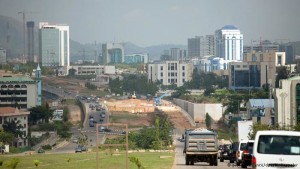
Imagen: http://euro.mediotiempo.com/media/2010/06/26/asientos.jpg
By Oseloka H. Obaze
High among the problems bedeviling Nigeria’s public service is the scourge of ghost workers. The problem is now a national crisis and a huge drain on the national economy. In a nation where personnel costs represent forty percent of government’s total recurrent expenditure, bilking of government via ghost workers constitutes a chunky portion of recurrent expenses. Recently, after a verification exercise among military retirees, the number of pensioners was reduced by 19,203, translating to a downward revision of monthly pension expenses by N575 million. The reduction was attributed to natural attrition, namely deaths since 2012.
Amidst the budget padding brouhaha, Finance Minister Kemi Adeosun revealed that 23,000 ghost workers were detected in the federal bureaucracy — the so-called Ministries, Departments and Agencies (MDAs). That number is certainly preliminary, since it’s far lower than the 62,893 revealed by erstwhile Minister of Finance, Dr. Ngozi Okonjo-Iweala a few years back. The ghost worker scourge is huge and related statistics alarming. Recent ghost workers discoveries within the states include, Plateau 5,000; Kano 8,000; Anambra 850; Kebbi 9,300; Osun 71; and Niger 7000. By extrapolation, the remaining thirty states could easily have between 100,000 to 151,000 ghost workers. Prevailing figures indicate that there is one ghost worker to three legitimate workers in Nigeria’s public service. Reportedly, some 71,135 ghost pensioners exist on the federal government payroll.
Ghost workers essentially represent dysfunctionality in governance. The ghost workers problem, which ought to be an aberration in any proper self-accounting and self-auditing bureaucratic system, is now a national scourge that warrants urgent remedial measures. A ghost worker is a payroll personality, not actually employed by the paying public service institution. Ghost workers exist as a person or only in name. Ghost workers disenfranchise other Nigerians by collecting wages and entitlements not due to them. Some are double dippers, who do one job but collect wages at two pay points.
Ghost workers exist because every bureaucracy creates its own weaknesses. This is not peculiar to Nigeria. Evidence points to high occurrence of ghost workers in Third World countries. In 2014, Kenya discovered 12,000 ghost workers on its payroll; mainly person who continued to receive salaries after leaving government service. In 2015, Cameroon identified 10,000 ghost workers within its 220,000 civil service cadre that cost the government $12million monthly. In Yemen using a biometric system, the government detected 5,875 ghost workers in a 485,818 work force. In Nigeria ghost workers run in the hundreds of thousands, because of willful and complicit phantom paymasters. What was once an aberration resulting from minor personnel or accounting errors is now a scam that exploits lax oversight and weak enforcement of extant public service rules and regulations.
The ghost worker scourge is fiscal. The motivation is greed. Those who orchestrate ghost workers merely tap into the seemingly depthless resources of the government. Most State budgets like the federal budget are frontloaded with recurrent expenditure. A huge subset of that fiscal burden is dedicated to personnel emolument; and a high percentage of the personnel emolument currently go to ghost workers. The problem of ghost workers is so big, insidious and entrenched in the Nigerian bureaucracy that the nation is losing billions in the three tiers of government. Human resources managers at the federal, state and local government levels are mainly culpable; so too is the approving and accounting officers. These officials are not clueless of the origins of ghost workers and how to plug the loopholes. Rather, they willfully embrace such loopholes or in the least, pretend such loopholes do not exist, because they and their cohorts are the beneficiaries. Ironically, the ghost workers problem is far more rampant in the public service bureaucracy and less so, in the organized private sector. This fact alone, affirms ghost worker proliferation as a public policy failure, which solution lies in the realm of hard-headed problem solving.
The attendant cost of ghost workers to the Nigerian taxpayer is mindboggling. The federal government alone reportedly saved some N208 billion by putting in place the Integrated Personnel Information System (IPSIS), a personnel payroll management and auditing system that flushes out ghost workers. Finance Minister Adeosun recently alluded to the FGN saving N100bn in personnel costs from the yet to be approved FY 2016 Budget. Cumulative national costs remain a matter of conjecture, but certainly run into billions.
Tackling problem source requires Periodic review of hiring and firing policies and ensuring that they comply with establishment and appropriated recruitment figures. Periodic census of public service personnel and the maintenance of records of all official and natural personnel attrition, including sacks, retirements and deaths; Maintaining an organigram of every MDA that reflects approved staff strength; Identifying the accounting officers, mostly in the Offices of the Heads of Service responsible for monitoring establishment quotas, and handling public service recruitment and separations and approving salary vouchers sent to banks; Installing fail-safe redundancies in electronic information technology platforms that check overrides and inputs into the system used for preparing payrolls; Ensuring that personnel and supernumeraries brought in by political appointees also depart with their principals; Working with labour unions concerned that innocent civil servants, with incomplete documentation, but not necessarily ghost workers will be disenfranchised; Strong internal controls that dispense with all forms of cash payment for emoluments; Adequate monitoring of banks and other financial institutions including micro-finance banks used for payment of salaries.
Transparency and Accountability remain essential to solving ghost worker challenges and caging the problem. Without question, fraudulent acts by most ghost workers originate with payroll personnel. Since ghost salaries results from manipulation of payroll technology, blocking such pilfering will require blocking prospective technological loopholes. Thus caging the ghost workers require a uniform and concerted personnel recruitment and civil service census policy that must be in tandem with the payroll data management. Additional cluster of measures required include, automated mapping of payroll; disbursement of salary only to employees’ accounts; use biometric attendance devices; opening accounts for new employees tied to their BVNs from the onset; Segregating duties related to payroll preparation, disbursement and distribution; and finally, ensuring that sequenced pay slips are prepared for the employees, during pay periods. These are not original ideas and are already being used piecemeal in some establishments. Yet to be maximally effective, a holistic approach is required.
The problem of ghost workers is essentially dual-tracked; identifying correctly those who collect wages for work done and those who collect wages for work not done, or exist in the workforce only in name. The solution is surprisingly simple but requires drastic intrusive measures. This is because those executives that create ghost workers are also the ones that are routinely charged with conduct of oversight and auditing. Hence while ghost worker may be reduced through internal mechanisms, the scourge will not disappear entirely unless there is a concerted top-to-bottom effort and the political will to tackle the scourge. A singular answer is spontaneous forensic audits and reviews managed by top executives and carried out entirely by outsiders. It’s that simple.
The author is a public policy adviser, consultant and immediate past Secretary to the Anambra State Government.
In: allafrica






